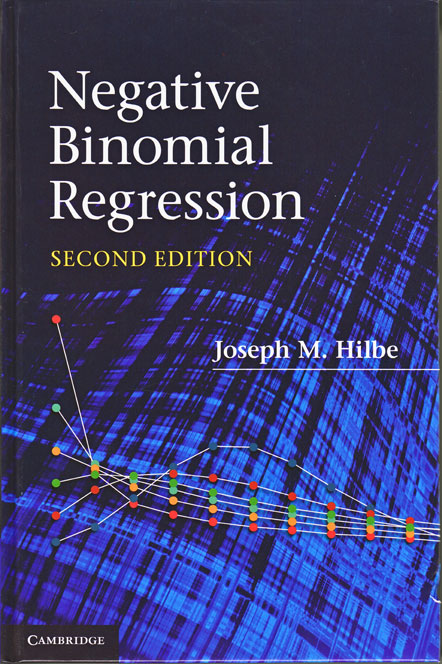Negative Binomial Regression, Second Edition, by Joseph M. Hilbe, reviews the negative binomial model and its variations. Negative binomial regression—a recently popular alternative to Poisson regression—is used to account for overdispersion, which is often encountered in many real-world applications with count responses.
Negative Binomial Regression covers the count response models, their estimation methods, and the algorithms used to fit these models. Hilbe details the problem of overdispersion and ways to handle it. The book emphasizes the application of negative binomial models to various research problems involving overdispersed count data. Much of the book is devoted to discussing model-selection techniques, the interpretation of results, regression diagnostics, and methods of assessing goodness of fit.
Hilbe uses Stata extensively throughout the book to display examples. He describes various extensions of the negative binomial model—those that handle excess zeros, censored and truncated data, panel and longitudinal data, and data from sample selection.
Negative Binomial Regression is aimed at those statisticians, econometricians, and practicing researchers analyzing count-response data. The book is written for a reader with a general background in maximum likelihood estimation and generalized linear models, but Hilbe includes enough mathematical details to satisfy the more theoretically minded reader.
This second edition includes added material on finite-mixture models; quantile-count models; bivariate negative binomial models; and various methods of handling endogeneity, including the generalized method of moments.
Preface to the Second Edition
1. INTRODUCTION
What is a negative binomial model?
A brief history of the negative binomial
Overview of the book
2. THE CONCEPT OF RISK
Risk and 2 × 2 tables
Risk and 2 × k tables
Risk ratio confidence intervals
Risk difference
The relationship of risk to odds ratios
Marginal probabilities: joint and conditional
3. OVERVIEW OF COUNT RESPONSE MODELS
Varieties of count response model
Estimation
Fit considerations
4. METHODS OF ESTIMATION
Derivation of the IRLS algorithm
Solving for ? L or U — the gradient
Solving for ?2 L
The IRLS fitting algorithm
Newton–Raphson algorithms
Derivation of the Newton–Raphson
GLM with OIM
Parameterizing from ? to x??
Maximum likelihood estimators
5. ASSESSMENT OF COUNT MODELS
Residuals for count response models
Model fit tests
Traditional fit tests
Information criteria fit tests
Validation models
6. POISSON REGRESSION
Derivation of the Poisson model
Derivation of the Poisson from the binomial distribution
Derivation of the Poisson model
Synthetic Poisson models
Construction of synthetic models
Changing response and predictor values
Changing multivariable predictor values
Example: Poisson model
Coefficient parameterization
Incidence rate ratio parameterization
Predicted counts
Effects plots
Marginal effects, elasticities, and discrete change
Marginal effects for Poisson and negative binomial effects models
Discrete change for Poisson and negative binomial models
Parameterization as a rate model
Exposure in time and area
Synthetic Poisson with offset
Example
7. OVERDISPERSION
What is overdispersion?
Handling apparent overdispersion
Creation of a simulated base Poisson model
Delete a predictor
Outliers in data
Creation of interaction
Testing the predictor scale
Testing the link
Methods of handling real overdispersion
Scaling of standard errors / quasi-Poisson
Quasi-likelihood variance multipliers
Robust variance estimators
Bootstrapped and jackknifed standard errors
Tests of overdispersion
Score and Lagrange multiplier tests
Boundary likelihood ratio test
R2p and R2pd tests for Poisson and negative binomial models
Negative binomial overdispersion
8. NEGATIVE BINOMIAL REGRESSION
Varieties of negative binomial
Derivation of the negative binomial
Poisson–gamma mixture model
Derivation of the GLM negative binomial
Negative binomial distributions
Negative binomial algorithms
NB-C: canonical negative binomial
NB2: expected information matrix
NB2: observed information matrix
NB2: R maximum likelihood function
9. NEGATIVE BINOMIAL REGRESSION: MODELING
Poisson versus negative binomial
Synthetic negative binomial
Marginal effects and discrete change
Binomial versus count models
Examples: negative binomial regression
Example 1: Modeling number of marital affairs
Example 2: Heart procedures
Example 3: Titanic survival data
Example 4: Health reform data
10. ALTERNATIVE VARIANCE PARAMETERIZATIONS
Geometric regression: NB ? = 1
Derivation of the geometric
Synthetic geometric models
Using the geometric model
The canonical geometric model
NB1: The linear negative binomial model
NB1 as QL-Poisson
Derivation of NB1
Modeling with NB1
NB1: R maximum likelihood function
NB-C: Canonical negative binomial regression
NB-C overview and formulae
Synthetic NB-C models
NB-C models
NB-H: Heterogeneous negative binomial regression
The NB-P model: generalized negative binomial
Generalized Waring regression
Bivariate negative binomial
Generalized Poisson regression
Poisson inverse Gau
11. PROBLEMS WITH ZERO COUNTS
Zero-truncated count models
Hurdle models
Theory and formulae for hurdle models
Synthetic hurdle models
Applications
Marginal effects
Zero-inflated negative binomial models
Overview of ZIP/ZINB models
ZINB algorithms
Applications
Zero-altered negative binomial
Tests of comparative fit
ZINB marginal effects
Comparison of models
12. CENSORED AND TRUNCATED COUNT MODELS
Censored and truncated models — econometric parameterization
Truncation
Censored models
Censored Poisson and NB2 models — survival parameterization
13. HANDLING ENDOGENEITY AND LATENT CLASS MODELS
Finite mixture models
Basics of finite mixture modeling
Synthetic finite mixture models
Dealing with endogeneity and latent class models
Problems related to endogeneity
Two-stage instrumental variables approach
Generalized method of moments (GMM)
NB2 with an endogenous multinomial treatment variable
Endogeneity resulting from measurement error
Sample selection and stratification
Negative binomial with endogenous stratification
Sample selection models
Endogenous switching models
Quantile count models
14. COUNT PANEL MODELS
Overview of count panel models
Generalized estimating equations: negative binomial
The GEE algorithm
GEE correlation structures
Negative binomial GEE models
GEE goodness-of-fit
GEE marginal effects
Unconditional fixed-effects negative binomial model
Conditional fixed-effects negative binomial model
Random-effects negative binomial
Mixed-effects negative binomial models
Random-intercept negative binomial models
Non-parametric random-intercept negative binomial
Random-coefficient negative binomial models
Multilevel models
15. BAYESIAN NEGATIVE BINOMIAL MODELS
Bayesian versus frequentist methodology
The logic of Bayesian regression estimation
Applications
APPENDIX A: CONSTRUCTING AND INTERPRETING INTERACTION TERMS
APPENDIX B: DATA SETS, COMMANDS, FUNCTIONS


